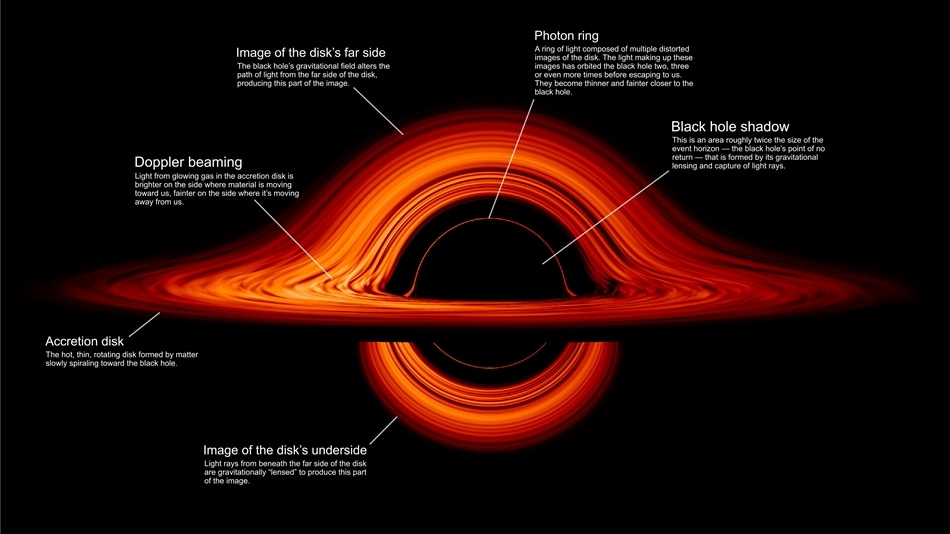Sep 27 2019
Researchers have visualized a black hole in a new way, which describes how its gravity warps its surroundings, as though observed in a carnival mirror, and thus distorts humans’ view.
 This image highlights and explains various aspects of the black hole visualization. (Image credits: NASA’s Goddard Space Flight Center/Jeremy Schnittman)
This image highlights and explains various aspects of the black hole visualization. (Image credits: NASA’s Goddard Space Flight Center/Jeremy Schnittman)
This visual representation mimics the appearance of a black hole in which infalling matter has accumulated into a thin and hot structure known as an accretion disk. The intense gravity of the black hole skews light discharged from various regions of the accretion disk and creates the distorted appearance.
The winding and twisting of magnetic fields through the churning gas lead to the constant formation and dissipation of bright knots in the accretion disk. Very close to the black hole, the gas orbits almost at the speed of light, whereas the external portions spin slightly slower. Due to this difference, the bright knots stretch and shear, resulting in dark and light lanes in the accretion disk.
When the disk is observed from the side, it appears brighter on the left than it does on the right. On the left side of the disk, glowing gas travels toward the observers at a very high speed such that the impacts of Einstein’s relativity further improve its brightness.
The reverse occurs on the right side of the disk, where the gas moving away from the observers turns out to be somewhat dimmer. This asymmetry vanishes when the disk is observed precisely face on. The reason is no material moves along the humans’ line of vision from that standpoint.
Very close to the black hole, the gravitational light-bending becomes so intense that the underside of the disk can be observed as a bright ring of light, apparently highlighting the black hole. This supposed “photon ring” is made up of numerous rings—becoming gradually thinner and fainter—of light. This light orbits the black hole two, three, or even more number of times and subsequently escapes to reach the observers’ eyes.
Since the black hole prototyped in this visualization is spherical, the photon ring appears almost circular in shape and the same from all viewing angles. The shadow of the black hole lies within the photon ring. It is an area that is almost two-fold the size of the event horizon—its point of no return.
Simulations and movies like these really help us visualize what Einstein meant when he said that gravity warps the fabric of space and time. Until very recently, these visualizations were limited to our imagination and computer programs. I never thought that it would be possible to see a real black hole.
Jeremy Schnittman, Goddard Space Flight Center, NASA
Schnittman created these incredible images with the help of custom software available at NASA’s Goddard Space Flight Center in Greenbelt, Maryland. However, on April 10th, 2019, the Event Horizon Telescope group revealed the world’s first image of the shadow of a black hole using radio observations of the core of the M87 galaxy.